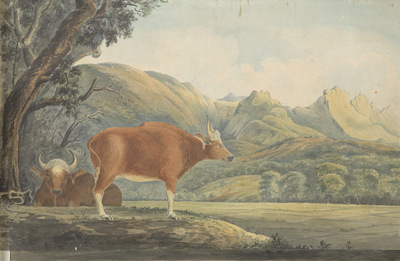Javascript must be enabled to continue!
f.11 Wild buffalo
View through Europeana Collections
Water-colour drawing by John Johnson of a water
buffalo taken from a sketch-book of 36 drawings (36 folios)
depicting scenes chiefly in W. India and Mysore, dated
c.1795-1801.The wild water buffalo is the ancestor of the domestic
water buffalo, which is now found in most tropical and subtropical
regions. It originally ranged from eastern Nepal and India, east to
Vietnam, and south to Malaysia. The interbreeding with domestic
buffalo, the loss of habitat due to cultivation, large-scale
poaching and communal hunting have drastically reduced the wild
buffalo population which is now under severe threat. The wild water
or Asian buffalo is a massive and powerful animal. It is dark brown
in color, with short, sparse hair and has broad, flat, notched
horns. It is found in wet grasslands and marshes, near pools and
near large rivers. These animals are very dependent on the
availability of water and are primarily grazers and, when not
feeding, spend the majority of their day bathing and
wallowing.
Title: f.11 Wild buffalo
Description:
Water-colour drawing by John Johnson of a water
buffalo taken from a sketch-book of 36 drawings (36 folios)
depicting scenes chiefly in W.
India and Mysore, dated
c.
1795-1801.
The wild water buffalo is the ancestor of the domestic
water buffalo, which is now found in most tropical and subtropical
regions.
It originally ranged from eastern Nepal and India, east to
Vietnam, and south to Malaysia.
The interbreeding with domestic
buffalo, the loss of habitat due to cultivation, large-scale
poaching and communal hunting have drastically reduced the wild
buffalo population which is now under severe threat.
The wild water
or Asian buffalo is a massive and powerful animal.
It is dark brown
in color, with short, sparse hair and has broad, flat, notched
horns.
It is found in wet grasslands and marshes, near pools and
near large rivers.
These animals are very dependent on the
availability of water and are primarily grazers and, when not
feeding, spend the majority of their day bathing and
wallowing.
Related Results
Dolman of wild mink fur, England, ca. 1885. Dolman of wild mink fur. It is hip length and has curved arms, a back shaped to accomodate a bustle and pendant ends in the front. The lining is of quilted brown satin and inside the neck is the label. It is tri
Dolman of wild mink fur, England, ca. 1885. Dolman of wild mink fur. It is hip length and has curved arms, a back shaped to accomodate a bustle and pendant ends in the front. The lining is of quilted brown satin and inside the neck is the label. It is tri
Dolman of wild mink fur, England, ca. 1885. Dolman of wild mink fur. It is hip length and has curved arms, a back shaped to accomodate a bustle and pendant ends in the front. The l...
Boys and Water Buffalo Approaching a Gate
Boys and Water Buffalo Approaching a Gate
Once affixed to a folding-fan frame, this painting is now mounted flat as an album leaf. The painting, which Lü Yao did in ink and light colors on gold-flecked paper, represents tw...
Parflêche bag
Parflêche bag
Parfleche envelope; Southern Ute; ca. 1875Rawhide, pigment and native leather; 95 x 40 cm. \nRMV 362-202; collected by Herman ten Kate on the Southern Ute Reservation, September 18...
Tobacco pouch
Tobacco pouch
"362-22" "Two Bears Band, Fort Rice.″Yanktonai pipe bag; wool, glass, porcupine quills; l. 43.5/73 cm., w. 16.5 cm.; ca. 1860s.″Documentation: \Two Bears band, Fort Rice.‖ Purchase...




